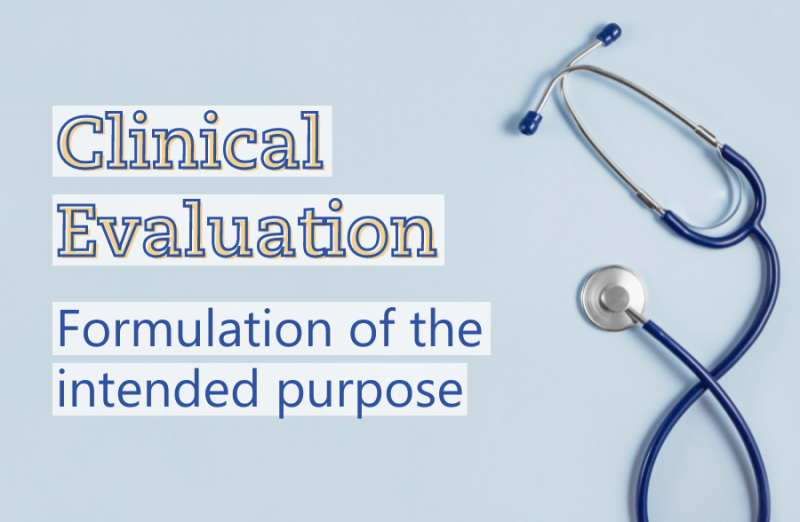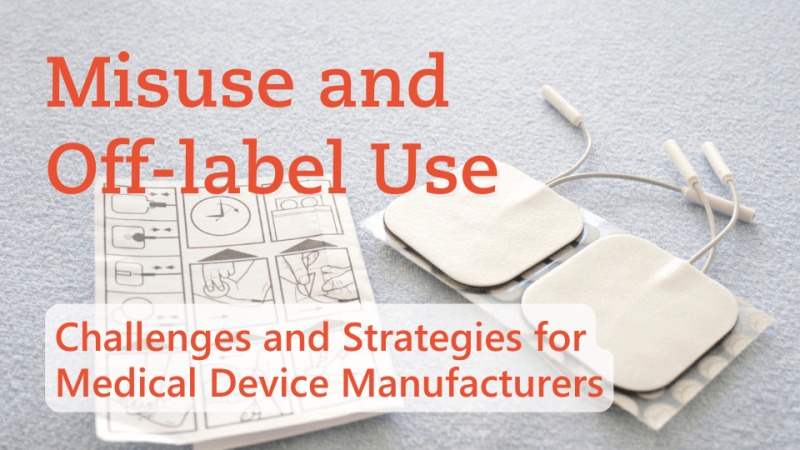Clinical Evaluation of medical devices: Why formulating the intended purpose should occur early
22/09/2023
Do you have any questions about the article or would you like to find out more about our services? We look forward to hearing from you!Make a non-binding enquiry now
The intended purpose of a medical device serves as the foundation for its clinical evaluation and is a part of the Technical Documentation. Formulating its elements should occur early and must align with the definition provided by the European Medical Device Regulation (EU) MDR 2017/745. In this article, we provide an overview of the crucial regulatory aspects regarding the description of the intended purpose and clinical benefits of a medical device.Clinical evaluation assesses the medical device within the scope of its intended purpose, which must be determined by the manufacturer for each product. According to Article 2(12) of the MDR, the intended purpose refers to the use for which a medical device is intended, as specified by the manufacturer on the label, in the instructions for use, or in the promotional or sales materials, as well as in its information for clinical evaluation.
For legacy devices (products already placed on the market under the old MDD directive), the intended purpose or instructions for use are only reluctantly changed in order to avoid competitive disadvantages or to maintain the established positioning of the product on the market. The challenge here often lies in the fact that, from a regulatory perspective, the "old" intended purpose or instructions for use may not work well, but the manufacturer may be hesitant to make changes from a marketing perspective.The correct description of the intended purpose is not always straightforward, and the MDR does not provide specific guidelines for its precise content. In contrast, the MDR provides detailed requirements for instructions for use in Chapter 23.4(b) and (c), stating that the instructions for use must include a clear description of the intended purpose of the product, including precise:
Precise definitions are often not easy to find in regulations like the MDR, so we will delve into the required contents of the intended purpose to provide more clarity.
The MDR is not as detailed, but essentially provides the same content under section 23.4 of Annex I:"The instructions for use shall include all the following particulars:
…b) the device's intended purpose with a clear specification of indications, contra-indications, the patient target group or groups, and of the intended users, as appropriate;
…"In the English-speaking world, there is often debate about the differences between "intended purpose" and "intended use." The MDR contributes to this confusion by using both terms, with "intended use" remaining undefined. Clarity is provided by MDCG 2020-6, which equates both terms.
"Indication" refers to the clinical condition that the medical device is intended to diagnose, prevent, monitor, treat, alleviate, compensate, replace, modify, or control through its use. Indications should be distinguished from the "intended purpose/use," which describes the effect of a product.While the intended purpose describes the mode of application of a medical device, indications describe the possible causes. These causes envision a clinical condition that can lead to the use of the medical device, such as a pathology (treatment) or a suspicion of a pathology (diagnosis).According to the fundamental safety and performance requirement 1 in Annex I of the MDR, the clinical evaluation should demonstrate the performance and safety of a medical device during its intended use, within the specified intended purpose, i.e., for all specified indications. To achieve this, it is advisable to consider "worst-case" indications, provided that the scientific justification for data transferability to other indications exists.MDCG 2020-6 also notes that not all medical devices have indications, citing examples such as products intended for disinfection and sterilization.
If the medical device itself does not have a therapeutic or diagnostic effect but supports or enables such effects in combination with other products, the clinical benefit is indirect.From the clinical benefit, clinically relevant performance aspects, methods, and parameters to be evaluated can be derived. The clinical evaluation has the task of providing evidence of these aspects and, together with the evidence of marketing claims and the entirety of risks, establishes the benefit-risk ratio. A well-considered formulation of the clinical benefit is therefore essential for providing evidence in the clinical evaluation.
Best regards
 Bianca Reiser
Bianca Reiser
What belongs in the product description?
The intended purpose, instructions for use, and marketing materials are essential components of the product description within the context of a medical device's Technical Documentation. Commonly observed deficiencies in manufacturers' implementation include:- Inconsistencies,
- Unclear descriptions,
- Overly general descriptions, and
- Missing information.
For legacy devices (products already placed on the market under the old MDD directive), the intended purpose or instructions for use are only reluctantly changed in order to avoid competitive disadvantages or to maintain the established positioning of the product on the market. The challenge here often lies in the fact that, from a regulatory perspective, the "old" intended purpose or instructions for use may not work well, but the manufacturer may be hesitant to make changes from a marketing perspective.The correct description of the intended purpose is not always straightforward, and the MDR does not provide specific guidelines for its precise content. In contrast, the MDR provides detailed requirements for instructions for use in Chapter 23.4(b) and (c), stating that the instructions for use must include a clear description of the intended purpose of the product, including precise:
- indications,
- contraindications,
- target patient groups,
- intended users (as applicable), and
- possibly additional details regarding the expected clinical benefit.
Precise definitions are often not easy to find in regulations like the MDR, so we will delve into the required contents of the intended purpose to provide more clarity.
Definition of intended purpose
The definition of the intended purpose has slightly changed from the Medical Device Directive (MDD) to the MDR:From "use for which the device is intended according to the data supplied by the manufacturer on the labelling, in the instructions and/or promotional materials" (Art. 1.2(g), MDD)To "use for which a device is intended according to the data supplied by the manufacturer on the label, in the instructions for use or in promotional or sales materials or statements and as specified by the manufacturer in the clinical evaluation" (Art 2(12), MDR)The new definition emphasizes the importance of consistency with clinical evaluation, which should demonstrate the performance and safety of the medical device when used within the intended purpose specified by the manufacturer. Furthermore, the definition in the MDR also includes sales materials, such as white papers and technical data sheets, as well as information provided in statements authored by the manufacturer.Additionally, there is a helpful passage from Annex III of MEDDEV 2.7.1 rev. 4, which presents the intended purpose as an overarching term:"Intended Purpose of the device:- exact medical indications (if applicable)
- name of disease or condition/ clinical form, stage, severity/ symptoms or aspects to be treated, managed, or diagnosed
- patient populations (adults / children / infants, other aspects)
- Intended user (use by health care professional / lay person)
- Organs / parts of the body / tissues or body fluids contacted by the device
- Duration of use or contact with the body
- Repeat applications, including any restrictions as to the number or duration of applications
- Contact with mucous membranes/ invasiveness/ implantation
- Contraindications
- Precautions required by the manufacturer
- Single-use / reusable
- Other aspects
The MDR is not as detailed, but essentially provides the same content under section 23.4 of Annex I:"The instructions for use shall include all the following particulars:
…b) the device's intended purpose with a clear specification of indications, contra-indications, the patient target group or groups, and of the intended users, as appropriate;
…"In the English-speaking world, there is often debate about the differences between "intended purpose" and "intended use." The MDR contributes to this confusion by using both terms, with "intended use" remaining undefined. Clarity is provided by MDCG 2020-6, which equates both terms.
1 Indications
A definition of the term "indication" is lacking in both the MDD and the MDR. MDCG 2020-6 clarifies this:"Indication" refers to the clinical condition that the medical device is intended to diagnose, prevent, monitor, treat, alleviate, compensate, replace, modify, or control through its use. Indications should be distinguished from the "intended purpose/use," which describes the effect of a product.While the intended purpose describes the mode of application of a medical device, indications describe the possible causes. These causes envision a clinical condition that can lead to the use of the medical device, such as a pathology (treatment) or a suspicion of a pathology (diagnosis).According to the fundamental safety and performance requirement 1 in Annex I of the MDR, the clinical evaluation should demonstrate the performance and safety of a medical device during its intended use, within the specified intended purpose, i.e., for all specified indications. To achieve this, it is advisable to consider "worst-case" indications, provided that the scientific justification for data transferability to other indications exists.MDCG 2020-6 also notes that not all medical devices have indications, citing examples such as products intended for disinfection and sterilization.
2 Contraindications
A definition for the term "contraindication" is also absent from the MDD, MDR, or MEDDEV. Only the FDA (U.S. Food and Drug Administration) provides a definition in the Guidance on Medical Device Patient Labelling; Final Guidance for Industry and FDA Reviewers (as of April 19, 2001):"Contraindications are conditions under which the device should not be used because the risk of use clearly outweighs any possible benefit."Again, these are clinical conditions that make the use of the product inadvisable. Typically, the application of a medical device is contraindicated for pregnant or lactating women or minors when clinical data with these population groups is lacking. Another common contraindication is:"[Allergy or] hypersensitivity to a material in the device."Contraindications can be categorized as absolute (prohibiting use entirely) or relative (allowing use in specific cases despite a negative risk-benefit ratio).3 Target patient group
The specified target patient group is not defined by regulations but can be inferred from indications and contraindications. The description of the target patient group should include the following information:- Age,
- Gender,
- Clinical condition,
- The severity of the clinical condition, and
- Other prerequisites for the use of the medical device.
4 Intended user group (and application environment)
The MDR specifies in Annex I, under essential safety and performance requirement 5, that the manufacturer must consider the following factors in product design when excluding or reducing risks related to application errors concerning the intended users:- Technical knowledge,
- Experience,
- Required training and education,
- Possibly, the application environment in which the medical device is intended to be used, and
- Health and physical condition.
5 Clinical benefit
The clinical benefit of a medical device specifies its positive impact on the health of the individual, be it the patient or the user, or the positive impact on patient management or public health. The clinical benefit is part of the product description and should be detailed and scientifically supported. Article 2(53) of the MDR requires the inclusion of meaningful, measurable, and patient-relevant clinical outcomes, including diagnostic results. Thus, not only is the term "clinical benefit" new compared to MDD, but also the requirement for quantification and measurability of the parameters.If the medical device itself does not have a therapeutic or diagnostic effect but supports or enables such effects in combination with other products, the clinical benefit is indirect.From the clinical benefit, clinically relevant performance aspects, methods, and parameters to be evaluated can be derived. The clinical evaluation has the task of providing evidence of these aspects and, together with the evidence of marketing claims and the entirety of risks, establishes the benefit-risk ratio. A well-considered formulation of the clinical benefit is therefore essential for providing evidence in the clinical evaluation.
Conclusion
The importance of consistency in the intended purpose is highlighted by the current definition in the MDR, which includes the clinical evaluation. The clinical evaluation aims to demonstrate the performance and safety of a medical device during its intended use by the user. The intended purpose is an essential component of every medical device and the core of the product description. During product development, the intended purpose should be carefully formulated in alignment with the marketing strategy because the evidence provision for clinical evaluation and many other documents in the Technical Documentation are guided by the intended purpose.Do you need assistance with creating the clinical evaluation or product description for your medical device? Or are you currently dealing with another complex issue related to Clinical Affairs or Technical Documentation and are in search of experienced professionals? Please feel free to contact us anytime. Together, we will find the best solution for your specific needs.Best regards
Our blog posts are researched and created with the utmost care, but are only snapshots of the regulations, which are constantly changing. We do not guarantee that older content is still current or meaningful. If you are not sure whether the article you have read on this page still corresponds to the current state of regulation, please contact us: we will quickly place your topic in the current context.

Medical Device Expert
Clinical Affairs & PMCF



